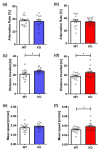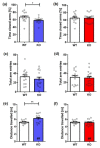Ablation of the Presynaptic Protein Mover Impairs Learning Performance and Decreases Anxiety Behavior in Mice
- PMID: 36232453
- PMCID: PMC9569738
- DOI: 10.3390/ijms231911159
Ablation of the Presynaptic Protein Mover Impairs Learning Performance and Decreases Anxiety Behavior in Mice
Abstract
The presynaptic protein Mover/TPRGL/SVAP30 is absent in Drosophila and C. elegans and differentially expressed in synapses in the rodent brain, suggesting that it confers specific functions to subtypes of presynaptic terminals. In order to investigate how the absence of this protein affects behavior and learning, Mover knockout mice (KO) were subjected to a series of established learning tests. To determine possible behavioral and cognitive alterations, male and female 8-week-old KO and C57Bl/6J wildtype (WT) control mice were tested in a battery of memory and anxiety tests. Testing included the cross maze, novel object recognition test (NOR), the Morris water maze (MWM), the elevated plus maze (EPM), and the open field test (OF). Mover KO mice showed impaired recognition memory in the NOR test, and decreased anxiety behavior in the OF and the EPM. Mover KO did not lead to changes in working memory in the cross maze or spatial reference memory in the MWM. However, a detailed analysis of the swimming strategies demonstrated allocentric-specific memory deficits in male KO mice. Our data indicate that Mover appears to control synaptic properties associated with specific forms of memory formation and behavior, suggesting that it has a modulatory role in synaptic transmission.
Keywords: SNARE; behavior; exploratory behavior; hippocampus; knockout mice; mover; spatial learning; synaptic facilitation; synaptic vesicles.
Conflict of interest statement
The authors declare no conflict of interest.
Figures






References
-
- Annamneedi A., Caliskan G., Muller S., Montag D., Budinger E., Angenstein F., Fejtova A., Tischmeyer W., Gundelfinger E.D., Stork O. Ablation of the presynaptic organizer Bassoon in excitatory neurons retards dentate gyrus maturation and enhances learning performance. Brain Struct. Funct. 2018;223:3423–3445. doi: 10.1007/s00429-018-1692-3. - DOI - PMC - PubMed
MeSH terms
LinkOut - more resources
Full Text Sources
Medical
Research Materials

